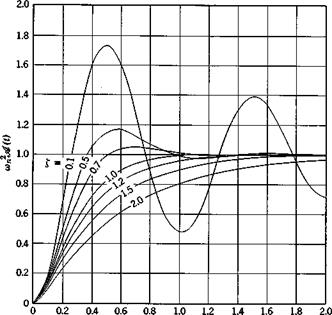RELATION BETWEEN IMPULSE RESPONSE AND AUTONOMOUS SOLUTION
It follows from (3.4,5a) that the matrix of impulse response functions H = [7i. w] is related to that of the transfer functions by
H(s) = G(s) (3.4,14)
Furthermore, from (3.2,23) we have that G(s) = B_1(s)C, so that
H(s) = B-!(s)C (3.4,15)
or B-!(s) = ЇВДС-1 (3.4,16)
Now in the autonomous case we have (3.3,4)
 |
||
Substitution of (3.4,16) into (3.3,4) yields the result for the autonomous solution with initial condition y(0), i. e.
STEP-FUNCTION RESPONSE
This is like the impulse response treated above except that the input is the unit step function 1(1), with transform 1/s. The response in this case is called the indicial admittance, and is denoted It follows then that
|
= адї(«) = — s |
(a) |
(3.4,18) |
|
|
or |
(b) |
Since the initial values (at t = 0~) of hi}(t) and are both zero, the
 |
|||
theorem (2.3,16) shows that
Thus can be found either by direct inversion of (3.4,186) (see examples
in Sec. 2.5) or by integration of By either method the results for first – and second-order systems are readily obtained, and are as follows (for a single input/output pair the indicial subscript is dropped) :
First-order system:
s/(t) = T( 1 – e~t/T) (3.4,20)
Second-order system:
![]() 1 — en<(eos cot — — sin a)t)l, £ < 1 (3.4,21)
1 — en<(eos cot — — sin a)t)l, £ < 1 (3.4,21)
со J
and for £ > 1, s/(t) is given by the r. h.s. of (2.5,5).
Graphs of the indicial responses are given in Figs. 3.96 and 3.11.
|
o>nt/2w Fig. 3.11 Indicial admittance of second-order systems. |












